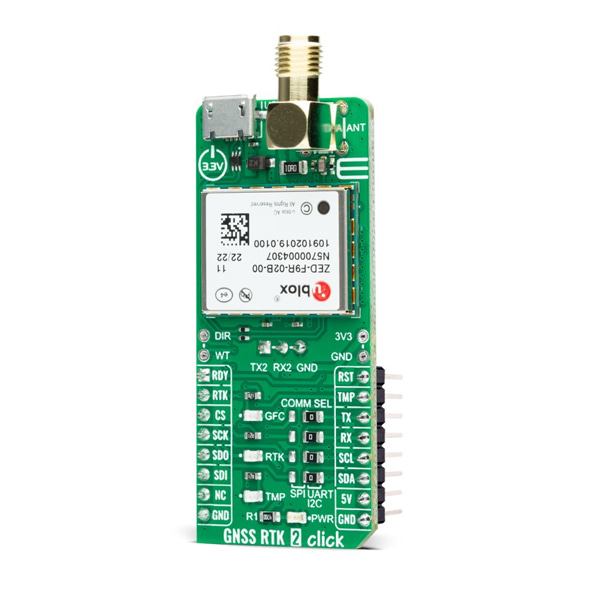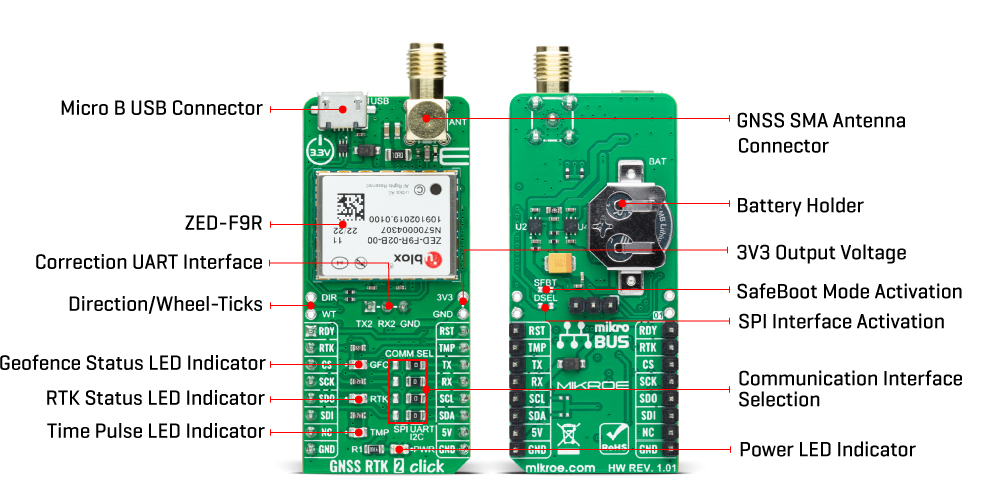멀티밴드 GNSS RTK 모듈 -ZED-F9R
(GNSS RTK 2 CLICK)

개요
- 본 제품은 GNSS RTK 모듈 -ZED-F9R 입니다.
- uBlox사의 멀티밴드 GNSS RTK ZED-F9R 칩을 기반으로 디자인된 제품입니다.
- 센티미터 수준의 정확성을 보여주며, GPS/QZSS, GLONASS, Galileo, BeiDou 위성 신호를 이용하여 안정적인 성능을 보여줍니다.
특징
-
HOW DOES IT WORK?
GNSS RTK 2 Click is based on the ZED-F9R, a multi-band professional-grade GNSS positioning module featuring the u-blox F9 receiver platform, providing a reliable multi-band GNSS sensor fusion solution for industrial applications. Thanks to the multi-band RF front-end architecture, all four major GNSS constellations (GPS, GLONASS, Galileo, and BeiDou) plus SBAS and QZSS satellites can be received concurrently. The ZED-F9R high-performance sensor fusion module also has an integrated inertial measurement unit (IMU) for centimeter-level accuracy RTK positioning (RTK rover feature).

The ZED-F9R's built-in algorithms fuse the IMU data, GNSS measurements, wheel ticks, correction data, and a vehicle dynamics model to provide optimal positioning accuracy where GNSS alone would fail. The module operates in the open sky, in the wooded countryside, in demanding multipath environments, and even in challenging environments such as cities. Designed for industrial applications, ZED-F9R is the ultimate solution for a data-driven economy where control and position availability are crucial.
This module represents a turnkey self-contained solution, eliminating the technical risk and effort of selecting and integrating RF components and third-party libraries such as precise positioning engines. It also offers support for a range of correction services, RTCM or SPARTN-formatted corrections, enabling high precision navigation using internet or satellite data through an unpopulated UART header in the middle of the board. This interface allows each application to optimize performance according to the application's unique needs.
GNSS RTK 2 Click communicates with a MCU using the UART interface at 115200bps as its default communication protocol with the option for users to use other interfaces, such as SPI and I2C, if they want to configure the module and write the library themselves. The interface is selected by positioning SMD jumpers labeled COMM SEL in an appropriate position. When choosing the SPI communication, with the correct selection of the COMM SEL jumpers, it is also necessary to populate the DSEL jumper to configure the interface pins as SPI. In the default state, the jumper labeled as DSEL is unpopulated. The receiver also can enter a Safe-Boot mode. When the jumper labeled SFBT is populated, the receiver starts in Safe-Boot mode, and the GNSS operation is disabled.
The USB interface, compatible with USB version 2.0 (Full Speed, 12 Mbit/s), can be used for communication as an alternative to the UART. The USB port can be used as an additional power supply if you the Click board™ is required to be a standalone device. In case of a mains supply failure, the module can use a backup supply voltage from a connected battery. Backup voltage supplies the real-time clock and battery-backed RAM and enables all relevant data to be saved in the backup RAM to allow a hot or warm start later.
In addition to these features, this board also uses several mikroBUS™ socket pins. RDY pin routed to the AN pin of the mikroBUS™ socket is used as a communication indicator when bytes are ready to be transmitted. The RST pin routed on the PWM pin of the mikroBUS™ socket provides the general reset ability, and the TMP pin, alongside its LED indicator, routed on the INT pin of the mikroBUS™ socket provides one pulse per second time pulse with configurable duration and frequency.
The RTK pin routed on the RST pin of the mikroBUS™ socket, alongside an LED indicator labeled RTK, indicates the RTK positioning status. When LED blinks, a valid stream of RTCM messages is received, but no RTK fixed mode has been achieved. When the LED is constantly lit, the LED indicates that RTK mode has been achieved. It also has another LED indicator labeled as GDC that shows the current geofence status as to whether the receiver is inside any active areas. For example, this feature can be used to wake up a sleeping host when a defined geofence condition is reached.
GNSS RTK 2 Click has an SMA antenna connector for connecting an appropriate antenna, also offered by Mikroe, such as GPS Active External Antenna. This antenna is an excellent choice for all GSM/GPRS applications supporting L1 and L2 band frequencies. This Click board™ can be operated only with a 5V logic voltage level. The board must perform appropriate logic voltage level conversion before using MCUs with different logic levels. However, the Click board™ comes equipped with a library containing functions and an example code that can be used as a reference for further development.
SPECIFICATIONS
Type GPS/GNSS Applications Can be used for high-precision positioning for demanding industrial applications On-board modules ZED-F9R - sensor fusion module with 3D sensors and a multi-band GNSS receiver from u-blox Key Features High precision, high performance, multi-band GNSS RX, centimeter-level accuracy, professional-grade, integrated IMU for RTK, selectable interface, support for RTCM soccections, geofence/RTK/time pulse indication, and more Interface GPIO,I2C,SPI,UART,USB Compatibility mikroBUS Click board size L (57.15 x 25.4 mm) Input Voltage 5V